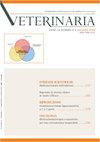INVESTIGATION OF HEALING EFFECTS OF THERMAL SPRING WATER AND MUD ON EXPERIMENTALLYINDUCED ATOPIC DERMATITIS IN MICE
Q4 Veterinary
引用次数: 0
Abstract
This study was conducted to determine the therapeutic efficacy of hot spring water and mud in atopic dermatitis. For this purpose, totally 40 Albino mice of the same daily age were used. All mice were treated with 2% 2,4-dinitrochlorobenzene after de-epilation in the dorsal region for creating atopic dermatitis. After disease formation, a 21-day treatment period was begun, and the mice were equally and randomly divided into two groups, control and study. Inter and intra-group comparisons of clinical, hematological and biochemical blood findings measured before and after the formation of atopic dermatitis, and on days 1, 7, 14 and 21 of the treatment period were performed in this study. In comparison with the control group on the last day of the study, it was seen that the body weight gain along with total leukocyte, neutrophil, monocyte, eosinophil counts and AST, LDH, GGT, OCT and IgE levels were significantly (p<0.05) decreased in the study group, whereas the mean heart and respiratory frequencies, erythrocyte and lymphocyte counts along with hemoglobin and hematocrit levels remarkably increased (p<0.05). There was no significant differences between the groups in terms of basophil count. Last day tissue samples showed that skin damage was significantly improved in the study group of animals, while it continued in the control group mice. Consequently, it was concluded that atopic dermatitis was improved in mice treated with Sureyya I hot spring water along with mud.温泉水和泥浆对实验性小鼠特应性皮炎愈合作用的研究
本研究旨在探讨温泉水加泥对特应性皮炎的治疗效果。为此,共使用40只相同日龄的白化病小鼠。所有小鼠在背部脱毛后用2% 2,4-二硝基氯苯治疗特应性皮炎。疾病形成后,开始21天的治疗期,将小鼠平均随机分为对照组和研究组。本研究对特应性皮炎形成前后及治疗期第1、7、14、21天的临床、血液学和生化血液检查结果进行组间和组内比较。与对照组比较,研究最后一天,研究组体重增加、白细胞、中性粒细胞、单核细胞、嗜酸性粒细胞总数、AST、LDH、GGT、OCT和IgE水平显著降低(p<0.05),平均心跳频率和呼吸频率、红细胞和淋巴细胞计数、血红蛋白和红细胞压积水平显著升高(p<0.05)。各组间嗜碱性粒细胞计数无显著差异。最后一天的组织样本显示,研究组动物的皮肤损伤明显改善,而对照组小鼠的皮肤损伤仍在继续。结果表明,苏雷雅1号温泉水加泥浆对小鼠特应性皮炎有改善作用。
本文章由计算机程序翻译,如有差异,请以英文原文为准。
求助全文
约1分钟内获得全文
求助全文
来源期刊

Veterinaria
农林科学-兽医学
CiteScore
0.10
自引率
0.00%
发文量
21
审稿时长
>12 weeks
期刊介绍:
VETERINARIA is the official scientific journal of the Italian Companion Animal Veterinary Association (SCIVAC) and is published bimonthly by Edizioni Veterinarie (E.V.). Its aim is to promote the spread and development of new ideas and techniques in the field of clinical and veterinary practices, with the ultimate goal of improving and promoting the continuing education of veterinary practicioners. VETERINARIA publishes literature reviews, original articles, diagnostic corners and clinical cases on different topics related to medicine and surgery of the dog, cat and of other companion animals, as well as short communications from congresses.
 求助内容:
求助内容: 应助结果提醒方式:
应助结果提醒方式:


